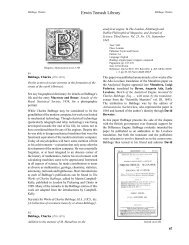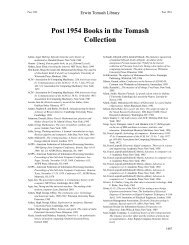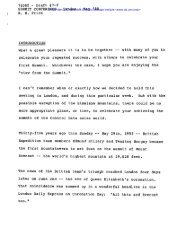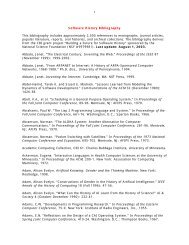M chapter.indd - Charles Babbage Institute
M chapter.indd - Charles Babbage Institute
M chapter.indd - Charles Babbage Institute
Create successful ePaper yourself
Turn your PDF publications into a flip-book with our unique Google optimized e-Paper software.
846<br />
Erwin Tomash Library<br />
Marshall, William P. Martin, Benjamin<br />
M 41<br />
Marshall, William P.<br />
M 40<br />
M 41<br />
<strong>Babbage</strong>’s calculating machine. In Proceedings of the<br />
Birmingham Philosophical Society, Vol. 1, 1879<br />
Year: 1879<br />
Place: Birmingham<br />
Publisher: Corns, Sherriff & Rattey<br />
Edition: 1st<br />
Language: English<br />
Figures: 5 engraved plates<br />
Binding: three-quarter-bound maroon leather; black leather<br />
label<br />
Pagination: pp. 33–48<br />
Size: 214x137 mm<br />
This paper is not another version of the many similar<br />
descriptions of <strong>Babbage</strong>’s difference engine. It contains<br />
illustrations of the actual gears and describes the<br />
actual mode of operation (as compared with the usual<br />
simplified version, based on that of Lardner (see<br />
Lardner, Dionysius; <strong>Babbage</strong>’s calculating engines,<br />
1834). Because of its unique nature, the illustrations for<br />
this entry show not only the diagrams but also the full<br />
text of the article.<br />
Illustrations available:<br />
Title page<br />
Figures<br />
Complete text<br />
M 42<br />
Martin, Benjamin (1705–1782)<br />
The description and use of a case of mathematical<br />
instruments; particularly of all the lines contained<br />
on the plain scale, the sector, the Gunter, and the<br />
proportional compasses. With a practical application,<br />
exemplified in many useful cases of geometry, and plain<br />
and spherical trigonometry. The whole illustrated by<br />
copper-plate figures.<br />
Year: 1790<br />
Place: London<br />
Publisher: P. & J. Dolland<br />
Edition: 2nd<br />
Language: English<br />
Figures: 1 folding plate<br />
Binding: disbound<br />
Pagination: pp. [2], 18<br />
Size: 212x133 mm<br />
Reference: Hambly DI, p. 47<br />
Nothing is known of Martin’s education, but since he<br />
was born in the small English village of Broadstreet, it is<br />
likely that he was largely self-taught. About 1730, he is<br />
known to have run a boarding school in Chichester, and<br />
by 1743 he was a traveling lecturer who became well<br />
known for his demonstrations of physical phenomena.<br />
He published a number of works, including a text based<br />
on his lectures. By 1755, he was in business with his<br />
son, as Martin and Son, in London selling scientific<br />
instruments. He seems to have functioned primarily as<br />
an instrument seller rather than as a maker, despite the<br />
fact that there are instruments that bear his name. Martin<br />
published a number of different books during this period,<br />
most of them oriented to the devices he sold. While he<br />
appears to have been willing to improve and sell almost<br />
any instrument, and was well known enough that his<br />
firm supplied Harvard University (then Harvard College)<br />
with instruments, he eventually went bankrupt. Shortly<br />
thereafter, he attempted suicide. While he survived for a<br />
few weeks, he eventually died from the attempt.







